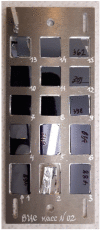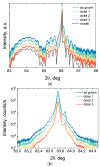Effect of Neutron Irradiation on the Electronic and Optical Properties of AlGaAs/InGaAs-Based Quantum Well Structures
- PMID: 37895731
- PMCID: PMC10608097
- DOI: 10.3390/ma16206750
Effect of Neutron Irradiation on the Electronic and Optical Properties of AlGaAs/InGaAs-Based Quantum Well Structures
Abstract
The effect of neutron irradiation on the structural, optical, and electronic properties of doped strained heterostructures with AlGaAs/InGaAs/GaAs and AlGaAs/InGaAs/AlGaAs quantum wells was experimentally studied. Heterostructures with a two-dimensional electron gas of different layer constructions were subjected to neutron irradiation in the reactor channel with the fluence range of 2 × 1014 cm-2 ÷ 1.2 × 1016 cm-2. The low-temperature photoluminescence spectra, electron concentration and mobility, and high-resolution X-ray diffraction curves were measured after the deactivation. The paper discusses the effect of neutron dose on the conductivity and optical spectra of structures based on InGaAs quantum wells depending on the doping level. The limiting dose of neutron irradiation was also estimated for the successful utilization of AlGaAs/InGaAs/GaAs and AlGaAs/InGaAs/AlGaAs heterostructures in electronic applications.
Keywords: InGaAs; electron concentration; high resolution X-ray diffraction; mobility; neutron irradiation; photoluminescence; two-dimensional electron gas.
Conflict of interest statement
The authors declare no conflict of interest. The funders had no role in the design of the study, in the collection, analyses, or interpretation of the data; in the writing of the manuscript; or in the decision to publish the results.
Figures







References
-
- Ďuran I., Entler S., Grover O., Bolshakova I., Výborný K., Kočan M., Jirman T., Vayakis G., Vasyliev O., Radishevskyi M., et al. Status of Steady-State Magnetic Diagnostic for ITER and Outlook for Possible Materials of Hall Sensors for DEMO. Fusion Eng. Des. 2019;146:2397–2400. doi: 10.1016/j.fusengdes.2019.03.201. - DOI
-
- Haned N. Nano-Tesla Magnetic Field Magnetometry Using an InGaAs–AlGaAs–GaAs 2DEG Hall Sensor. Sens. Actuators A Phys. 2003;102:216–222. doi: 10.1016/S0924-4247(02)00386-2. - DOI
-
- Sadeghi M., Sexton J., Liang C.W., Missous M. Highly Sensitive Nanotesla Quantum-Well Hall-Effect Integrated Circuit Using GaAs–InGaAs–AlGaAs 2DEG. IEEE Sens. J. 2015;15:1817–1824. doi: 10.1109/JSEN.2014.2368074. - DOI
-
- Khan M.A., Sun J., Li B., Przybysz A., Kosel J. Magnetic Sensors-A Review and Recent Technologies. Eng. Res. Express. 2021;3:022005. doi: 10.1088/2631-8695/ac0838. - DOI
-
- Bolshakova I., Shtabalyuk A., Shurygin F., Vasilevskii I., Viererbl L., Duran I., Kovalyova N., Kovarik K., Kost Y., Makido O., et al. Prospects of Using In-Containing Semiconductor Materials in Magnetic Field Sensors for Thermonuclear Reactor Magnetic Diagnostics. IEEE Trans. Magn. 2013;49:50–53. doi: 10.1109/TMAG.2012.2217482. - DOI
Grants and funding
LinkOut - more resources
Full Text Sources

